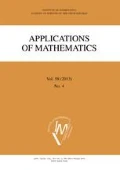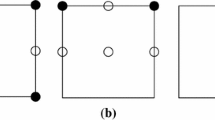Abstract
Let A: V → V′ be a strongly elliptic operator on a d-dimensional manifold D (polyhedra or boundaries of polyhedra are also allowed). An operator equation Au = f with stochastic data f is considered. The goal of the computation is the mean field and higher moments \(\mathcal{M}^1 u \in V,\mathcal{M}^2 u \in V \otimes V,...,\mathcal{M}^k u \in V \otimes ... \otimes V\) of the solution.
We discretize the mean field problem using a FEM with hierarchical basis and N degrees of freedom. We present a Monte-Carlo algorithm and a deterministic algorithm for the approximation of the moment \(\mathcal{M}^k u\) for k⩾1.
The key tool in both algorithms is a “sparse tensor product” space for the approximation of \(\mathcal{M}^k u\) with O(N(log N)k−1) degrees of freedom, instead of N k degrees of freedom for the full tensor product FEM space.
A sparse Monte-Carlo FEM with M samples (i.e., deterministic solver) is proved to yield approximations to \(\mathcal{M}^k u\) with a work of O(M N(log N)k−1) operations. The solutions are shown to converge with the optimal rates with respect to the Finite Element degrees of freedom N and the number M of samples.
The deterministic FEM is based on deterministic equations for \(\mathcal{M}^k u\) in D k ⊂ ℝkd. Their Galerkin approximation using sparse tensor products of the FE spaces in D allows approximation of \(\mathcal{M}^k u\) with O(N(log N)k−1) degrees of freedom converging at an optimal rate (up to logs).
For nonlocal operators wavelet compression of the operators is used. The linear systems are solved iteratively with multilevel preconditioning. This yields an approximation for \(\mathcal{M}^k u\) with at most O(N (log N)k+1) operations.
Similar content being viewed by others
References
I. Babuška: On randomized solution of Laplace’s equation. Čas. Pěst. Mat. 86 (1961), 269–276.
I. Babuška: Error-bounds for finite element method. Numer. Math. 16 (1971), 322–333.
I. Babuška, R. Tempone, and G. Zouraris: Galerkin finite element approximations of stochastic elliptic partial differential equations. SIAM J. Numer. Anal. 42 (2004), 800–825.
V. I. Bogachev: Gaussian Measures. AMS Mathematical Surveys and Monographs Vol. 62. AMS, Providence, 1998.
L. Breiman: Probability. Addison-Wesley, Reading, 1968.
W. A. Light, E.W. Cheney: Approximation Theory in Tensor Product Spaces. Lecture Notes in Mathematics Vol. 1169. Springer-Verlag, Berlin, 1985.
P. G. Ciarlet: The Finite Element Method for Elliptic Problems. Elsevier Publ. North Holland, Amsterdam, 1978.
M. Dahmen, H. Harbrecht, and R. Schneider: Compression techniques for boundary integral equations— optimal complexity estimates. SIAM J. Numer. Anal. 43 (2006), 2251–2271.
W. Dahmen, R. Stevenson: Element-by-element construction of wavelets satisfying stability and moment conditions. SIAM J. Numer. Anal. 37 (1999), 319–352.
S. C. Eisenstat, H. C. Elman, M. H. Schultz: Variational iterative methods for nonsymmetric systems of linear equations. SIAM J. Numer. Anal. 20 (1983), 345–357.
M. Griebel, P. Oswald, T. Schiekofer: Sparse grids for boundary integral equations. Numer. Math. 83 (1999), 279–312.
S. Hildebrandt, N. Wienholtz: Constructive proofs of representation theorems in separable Hilbert space. Commun. Pure Appl. Math. 17 (1964), 369–373.
G. C. Hsiao, W. L. Wendland: A finite element method for some integral equations of the first kind. J. Math. Anal. Appl. 58 (1977), 449–481.
S. Janson: Gaussian Hilbert Spaces. Cambridge University Press, Cambridge, 1997.
S. Larsen: Numerical analysis of elliptic partial differential equations with stochastic input data. Doctoral Dissertation. Univ. of Maryland, 1985.
M. Ledoux, M. Talagrand: Probability in Banach Spaces. Isoperimetry and Processes. Springer-Verlag, Berlin, 1991.
P. Malliavin: Stochastic Analysis. Springer-Verlag, Berlin, 1997.
W. McLean: Strongly Elliptic Systems and Boundary Integral Equations. Cambridge University Press, Cambridge, 2000.
J. C. Nédélec, J. P. Planchard: Une méthode variationelle d’éléments finis pour la résolution numérique d’un problème extérieur dans ℝ3. RAIRO Anal. Numér. 7 (1973), 105–129.
G. Schmidlin, C. Lage, and C. Schwab: Rapid solution of first kind boundary integral equations in ℝ 3. Eng. Anal. Bound. Elem. 27 (2003), 469–490.
T. von Petersdorff, C. Schwab: Wavelet approximations for first kind boundary integral equations in polygons. Numer. Math. 74 (1996), 479–516.
T. von Petersdorff, C. Schwab: Numerical solution of parabolic equations in high dimensions. M2AN, Math. Model. Numer. Anal. 38 (2004), 93–127.
R. Schneider: Multiskalen-und Wavelet-Matrixkompression. Advances in Numerical Mathematics. Teubner, Stuttgart, 1998.
C. Schwab, R. A. Todor: Sparse finite elements for elliptic problems with stochastic loading. Numer. Math. 95 (2003), 707–734.
C. Schwab, R. A. Todor: Sparse finite elements for stochastic elliptic problems—higher order moments. Computing 71 (2003), 43–63.
S. A. Smolyak: Quadrature and interpolation formulas for tensor products of certain classes of functions. Sov. Math. Dokl. 4 (1963), 240–243.
V. N. Temlyakov: Approximation of Periodic Functions. Nova Science Publ., New York, 1994.
G.W. Wasilkowski, H. Wozniakowski: Explicit cost bounds of algorithms for multivariate tensor product problems. J. Complexity 11 (1995), 1–56.
N. Wiener: The homogeneous Chaos. Amer. J. Math. 60 (1938), 987–936.
Author information
Authors and Affiliations
Additional information
This work was supported under IHP Network “Breaking Complexity” by the Swiss BBW under grant No. 02.0418
Rights and permissions
About this article
Cite this article
von Petersdorff, T., Schwab, C. Sparse finite element methods for operator equations with stochastic data. Appl Math 51, 145–180 (2006). https://doi.org/10.1007/s10492-006-0010-1
Received:
Issue Date:
DOI: https://doi.org/10.1007/s10492-006-0010-1



